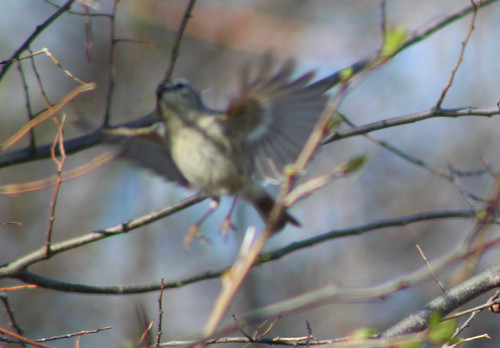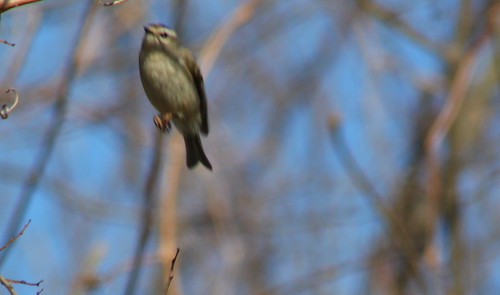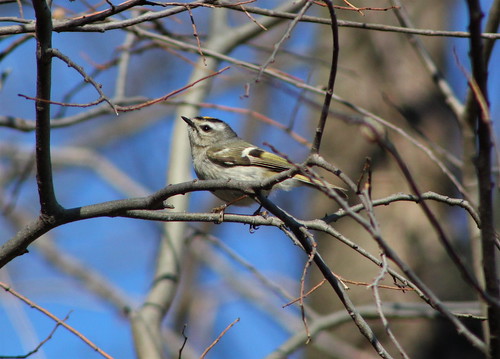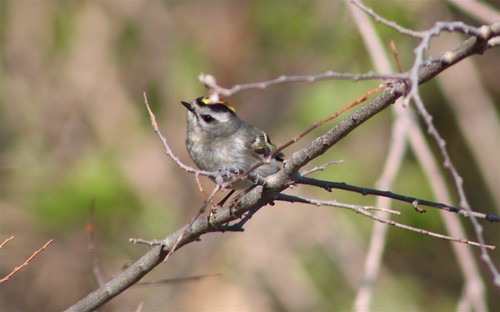Introducing one of the hardest birds to photograph. If you have managed to get a clear picture of this bird I tip my hat to you. I'm talking about lively antics of the Golden-crowned Kinglet. These guys are the ADD kindergartners of the bird world. They pop like popcorn form branch to branch, hanging upside down, flapping furiously in one spot, and hanging in mid-air as they search for insects.
I found a nice group of these guys today and spent around 20 minutes photographing them. They afforded me great views, but I am a little disappointed in the photos I got out of it. Most were blurry because the bird was in motion, flying to a different branch. Several shots were of nothing but a branch, the bird having flown before the shutter could close. I shot over 130 photos and only managed a handful of keepers. Below are what a majority of them looked like.
It should be no surprise why they are called Golden-crowned Kinglets, just look at the photo below. Their scientific name is Regulus satrapa meaning "king with a golden crown". Other than the golden crown, there are some other characteristics that set it apart. They have a dark stripe through the eye, and a white supercilium (eyebrow). They have white wing bars, a dull olive-green back, and a short tail. Their small size and constant activity and flapping are also good identification clues.
There are two species of kinglets in North America, the Golden-crowned and Ruby-crowned Kinglets. They are the only two species of kinglets in North America. They breed in the coniferous forests of Canada in the summer and winter in the United States as far south as Texas and Florida.
They are often seen in groups and are sometimes present in mixed species foraging flocks. These foraging flocks usually occur in the winter time when birds of several species come together and search for food in groups. These groups can be made up of a variety of species, but usually include chickadees, titmice, nuthatches, woodpeckers, warblers, and kinglets. Such was the case today. Along with the group of kinglets, I spotted a Hermit Thrush scratching in the leaves, a Brown Creeper moving up a tree trunk, chickadees, and a Yellow-throated Warbler gleaning insects from the leaves. These foraging flocks usually occur in the winter time. Why it occurs during winter might have something to do with the fact that this is not the breeding season for birds, therefore their hormone levels are low. This means they are less territorial and will allow other birds to enter their territory. The benefits of forming these groups outweigh the costs of allowing competitors onto your territory. One protection is that there are more eyes to spot predators. During the winter the trees are bare, making it easier for predators to spot prey. If you are foraging by yourself, you may be more likely to be picked off by a hawk than you would if you were foraging with a group of birds. Also, it is believed that foraging flocks improve the efficiency of finding prey, perhaps because arthropod prey that flee one bird may be caught by another.
Despite being slightly larger than a hummingbird, the Golden-crowned Kinglet somehow manages to breed in the coldest of climates in Northern Canada. This small size seems to me why they may be such active birds. They need to feed constantly to be able to thermoregulate and keep from freezing, much the same as hummingbirds.
Kinglets belong to the family Regulidae, a small family of birds living in the Holarctic (northern hemisphere) region. The Ruby and Golden-crowned Kinglets in North America, the Goldcrest, Common Firecrest, Madeira Firecrest in Eurasia, and the Flamecrest in Taiwan. They superficially resemble the warblers and were for a time included in the Old World Warbler family Sylvidae. There are several subspecies of Golden-crowned Kinglet, perhaps the most interesting being the subspecies that occur outside their core range. The subspecies aztecus and clarus live in the mountainous regions of Mexico and Guatemala, far from their usual breeding grounds in Canada. To me this seems like they are maybe diverging into separate species in this area.
As a side note, this post will be included in World Bird Wednesday. If you are interested in some of the best bird blogs on the web, then click the link below.



 11:30 PM
11:30 PM










 Posted in:
Posted in: 




10 comments:
I really liked your description of the constant motion of these birds and your photos matched this description beautifully.
A beautiful little bird, lovely images, many thanks for sharing.
Superb images! I have yet to get a good shot of this amazing bird! These make my heart sing :)
This is a lovely little bird. You must have worked very hard (and patiently) to get those shots!
So much to love here. Your essay is scholarly yet your respect for this amazing creature is warmly felt. The fact that you let on to the challenge involved in capturing your engaging and descriptive photographs is a lesson in the tenacity necessary to pull off a few perfect pictures. Bravo!
I have yet to see this pretty bird. Not only did you provide great info about their habits but also great photos. Thanks!
a wonderful and informative post about this lovely little bird!
Beautiful post with beautiful photos. I know the feeling of disappointment, but hey, you DID manage to get some clear shots AND the crown AND the antics ;)
Love all the Info too, well done!
Thanks all for the kind words.
Hehehe...you're so right! This winter a small flock always followed me every time i walked the Little Miami River. I took hundreds of photos, but only got a handful of nice photos! You have some lovely photos here.
Post a Comment